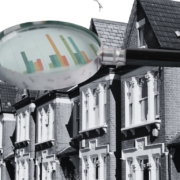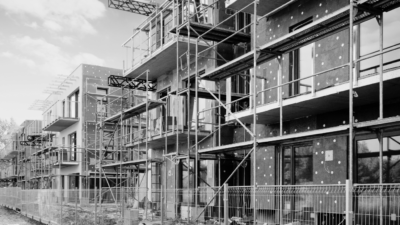Inflation appears finally to have taken a big step downwards, which will come as a big sigh of relief amid cost-of-living pain, but underlying prices are staying uncomfortably stubborn.
The pound has edged higher against the dollar with the big bets on the Bank of England pushing up interest rates again in September by another 25 basis points to 5.5%, and the high cost of borrowing set to linger.
When you strip out volatile food and fuel prices, which have fallen back more substantially, there has been no slowdown in rate of increases which is highly disappointing.
Core CPI flatlined at 6.9% in July, indicating that the headline rate might not budge much more immediately and there are some signs it could even edge back upwards.
We usually spend more on clothing in August due to millions of people heading back to school and work and the appeal of new seasonal ranges.
But also the sharp wage rise in June to the highest level since comparable records began more than two decades ago, has led to expectations that consumers will be more flash with their cash – which may mean companies will have less incentive to be competitive and bring down prices.
The prospect of more interest rate rises will take the edge off any relief people who have had to remortgage feel at rising wages.
With renters and homeowners facing their monthly costs rising by hundreds of pounds, a small real-term rise in salaries is unlikely to prove much solace.
Around 37% of people own their own home outright, so they are much more insulated by the ratcheting up in rates, and are likely to keep the tills ticking over nicely.
FTSE 100 has opened lower as investors assess the impact of higher rates on the prospects for domestically focused firms with borrowing costs set to rise again, while keeping an eye on chillier winds blowing in from around the world.
Strong retail sales data in the US has unnerved investors, with the realisation dawning yet again that the Federal Reserve job in calming inflation is not yet done.
It’s still set to be a bumpy ride to meet the 2% target, and the concern is that this won’t happen without a significant downturn in the economy.
Worry still reigns about China’s big slowdown after the property market shows further signs of deterioration.
Average prices of new homes in China’s big cities fell back in July, after a brief respite in June, showing a monthly decline of 0.2%.
It’s fresh evidence that the attempts to prop up the real estate sector by the People’s Bank of China with cuts to key loan rates are barely scratching the surface of the deep problems.
As concerns continue to swirl about the health of the world’s second largest economy more pressure is being put on commodity stocks amid expectations of weakening demand for crude, oil metals and minerals.
Investors are looking for a lot more welly before being more confident that the economy will be provided with more insulation.
Amid the uncertainty the price of Brent Crude has weakened, with a barrel currently trading below $85.
Commenting on inflation falling providing the final part of this week’s UK economic jigsaw puzzle, Charles White Thomson, CEO at Saxo UK, said:
“The final part of this week’s UK economic jigsaw puzzle is the key CPI or inflation growth which came in at 6.8%, a small miss on consensus, and down from a recent 7.9%. 515 basis points of interest rate hikes or harsh economic medicine is having its effect with the move down in inflation.
The MPC will be mildly pleased with these headlines as the difficult conundrum of reducing inflation, with the blunt weapon that are interest rates, without breaking the economy, at first glance appears to be working.
Earlier this week we had GDP, Industrial and Manufacturing production numbers which largely showed a healthy beat versus a depressed consensus.
These reports are encouraging and a needed boost for UK PLC.
At the risk of being a party pooper, we should remember that quarter on quarter GDP growth is an anaemic 0.2%, inflation is 3x the target and the consumer is on their knees saddled with debt that was once ‘given away’ cheap.
These numbers need to be built on, as a ‘flash in the pan’ would damage confidence significantly – consistency or stringing together a series of improved numbers is most important.
To the jigsaw we add an increase in unemployment to 4.2% which shows the employment market is resilient and tight, and wages are running hot as seen in the 7.8% wage growth.
This sort of wage growth is inflationary and will have caught the MPC’s eye.
The better than expected GDP number, high wage and inflation growth frees and pushes the Bank of England’s hand to continue the campaign to defeat inflation.
Core inflation remains stubbornly high. The view being there is enough resilience in the economy to hike again by 25bps, with peak rates at 5.75- 6.0%.
The Governor has reduced his strategic options with the ‘no ifs, no buts’ messaging and that is why the risk for further policy failure or over tightening is real.
Forecasting interest rate hike lag is highly challenging.
We need a monetary policy review, with fresh eyes including generalists, to answer how we got here including ‘how to break the cycle of group think’ amongst the key Economic decision makers.
The recent appointment of the distinguished member of the Economics establishment, Ben Bernanke, does not, in my view, represent a fresh set of eyes.”
Paresh Raja, CEO of Market Financial Solutions, comments:
“Another step in the right direction, with today’s CPI drop following on from the smaller-than-expected base rate hike at the start of the month.
But it might be a case of two steps forward, one step back; all the talk this week has been that we are in for a shock rise in inflation when next month’s data comes out on 20 September.
Given the Bank of England’s next interest rate decision follows the next day (21 September) that will likely prove a hugely important 48 hours.
For now, we should allow some positivity to permeate back into the property and lending markets.
After a challenging 18 months, any time inflation falls should be welcomed, and we could see such good news reflected in the products and rates available to property buyers.
Still, lenders must double down on a proactive approach to supporting brokers and borrowers who will be feeling the effects of high inflation and consistent base rate hikes.
In turn, lenders can help the market return to a more buoyant state.”
Jatin Ondhia, CEO of Shojin, comments:
“It’s good news today, but there are strong rumours that next month’s data will show a rise in inflation once again.
This story is far from over – Rishi Sunak and Jeremy Hunt’s target of bringing inflation under 5% by the end of the year is looking increasingly out of reach, and that will have implications on consumers, investors, businesses and the financial markets.
Even with today’s fall, inflation remains high, and if indeed it does rise again next month, we have to expect the Bank of England to come hard with more interest rates hikes.
As borrowing becomes more expensive, this will inevitably further impact house prices and property development.
For investors, meanwhile, it is crucial they assess how well positioned their portfolios are to deliver returns amid stickier-than-expected inflation.
Diversification will likely remain a watchword for investors.
Predicting quite where interest rates and inflation will go in the months to come is difficult, so many people will opt to diversify their investments so they are not tied too closely to any particularly market forecasts.”
Tom Bill, head of UK residential research at Knight Frank, comments:
“It has been a week of mixed signals for the UK property market.
Falling headline inflation suggests a faint light at the end of the tunnel but stronger than expected wage growth and core inflation indicates the Bank of England will believe its work raising rates isn’t quite done yet.
Some lenders are cutting rates, but for anyone buying, selling or re-mortgaging, it shows the upwards pressure on mortgage rates hasn’t gone away.
That said, demand in the property market will continue to be supported by wage growth (which is now outpacing inflation), lockdown savings, the availability of longer mortgage terms, lender flexibility and the popularity of fixed-rate deals in recent years.
We don’t expect a cliff-edge moment for prices but they will continue to come under pressure in the short term along with transaction volumes.
The normalisation of rates was not unexpected but the journey has been bumpy.
The previous government went too far, too fast for financial markets and the Bank of England has been accused of doing too little, too late.”

























Comments